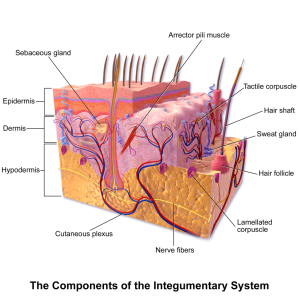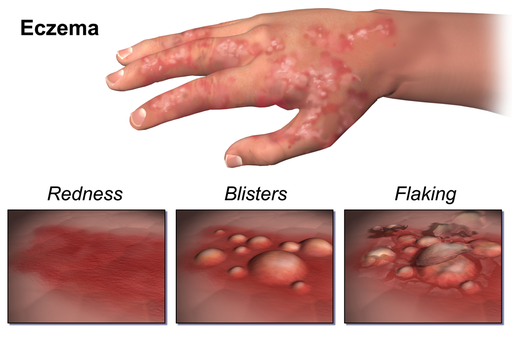6.10 Integumentary System
Overview and Functions
The integumentary system (Fig. 6.31) is one of the largest body systems and makes up approximately 16% of total body weight. The main component of this system is the skin, which is responsible for much more than simply contributing to your outward appearance. The skin protects the inner organs, controls thermoregulation, functions as a sensory organ, and is necessary for vitamin D synthesis. It is made up of multiple layers of cells and tissues that are held to underlying structures by connective tissues. The deepest layer of skin has many blood vessels and also has sensory, autonomic, and sympathetic nerve fibres that ensure communication to and from the CNS. Accessory organs within this system include hair, nails, and various glands.

(CrashCourse, 2015)
Components of the Integumentary System
Epidermis: This is the outermost skin layer and is composed of keratinized, stratified squamous epithelium.
Dermis: This inner skin layer is the main component of the integumentary system and contains blood and lymph vessels, nerves, and other structures, such as hair follicles and sweat glands.
Hypodermis: This layer is also known as the subcutaneous layer and lies below the dermis. It connects the skin to the fibrous tissues of the bones and muscles.
Hair: This is a keratinous filament that grows out of the epidermis. It is primarily made of dead, keratinized cells.
Nail bed: This epidermal structure is found at the tips of our fingers and toes. The nail body is formed on the nail bed and protects the tips of our fingers and toes and assists with picking up small objects.
Sudoriferous glands: Also known as sweat glands, these glands produce sweat to cool the body when it becomes warm. There are two types of sweat glands, and each secretes slightly different products.
Sebaceous glands: These glands are a type of oil gland and are found all over the body. They help to lubricate and waterproof the skin and hair. Many of these glands are found near hair follicles. The sebaceous glands generate and excrete sebum, which is a mixture of lipids, onto the skin surface, lubricating the dry and dead layer of keratinized cells. The secretion of sebum is stimulated by hormones, many of which do not become active until puberty.
Combining Forms
Table 6.9. Combining Forms
| COMBINING FORM | MEANING | EXAMPLE OF USE IN MEDICAL TERMS |
|---|---|---|
| cutane/o | skin | cutaneous |
| derm/o | skin | epidermal |
| dermat/o | skin | dermatologist |
| epitheli/o | skin (surface tissue) | epithelial |
| onych/o | nail | onycholysis |
| pil/o | hair | pilosebaceous |
| trich/o | hair | trichotillomania |
| ungu/o | nail | ungiectomy |
Common Pathologies
Acne: This condition commonly occurs in areas of the skin that have more sebaceous glands, such as the face and back. It is associated with hormones and commonly occurs with the onset of puberty.
Albinism: This genetic disorder affects the colouration of hair, eyes. and skin. Individuals with albinism appear white or very pale because of a lack of melanin.
Alopecia: This condition is characterized by hair loss or lack of hair where it would usually be (Fig. 6.32).

Basal cell carcinoma: This is a form of skin cancer that affects the epidermis. It is the most common form of skin cancer in certain parts of the world. It is often found on the neck, head, arms, and back because those areas are more likely to be exposed to the sun.
Eczema: This condition presents as an allergic reaction characterized by dry, itchy patches on the skin (Fig. 6.33). It often looks like a rash and can appear anywhere on the body. Eczema can progress, and the skin can become itchy, dry, swollen, and bleeding.

Melanoma: This type of cancer typically develops from a mole and then grows uncontrollably. It is highly malignant and is one of the most fatal types of cancer.
Key Concept
The ABCDE mnemonic is used to assess moles and can help with the diagnosis of early stage melanoma:
- Asymmetry – the two sides are not symmetrical
- Borders – the edges are irregular in shape
- Colour – the colour is varied shades of brown or black
- Diameter – it is larger than 6 mm (0.24 in)
- Evolving – its shape has changed
Mole: Also known as a nevus, a mole appears as a pigmented lesion on the skin. Many are benign in nature.
Psoriasis: This chronic autoimmune disorder is characterized by patches of thick, red skin with the appearance of silvery scales. Psoriasis can be found on the elbows, knees, scalp, low back, face, feet, fingernails, toenails, and even the mouth (Carter & Rutherford, 2020).
Squamous cell carcinoma: This form of skin cancer is more aggressive than basal cell carcinoma and is the second most common type of skin cancer. It is often found on the scalp, ears, and hands, and affects the keratinocytes in the dermis and epidermis.
Exercise
Attribution
Unless otherwise indicated, material on this page has been adapted from the following resource:
Betts, J. G., Young, K. A., Wise, J. A., Johnson, E., Poe, B., Kruse, D. H., Korol, O., Johnson, J. E., Womble, M., & DeSaix, P. (2013). Anatomy and physiology. OpenStax. https://openstax.org/details/books/anatomy-and-physiology licensed under CC BY 4.0
References
Carter, K., & Rutherford, M. (2020). Building a medical terminology foundation. eCampusOntario. https://ecampusontario.pressbooks.pub/medicalterminology/ licensed under CC BY 4.0
Ernstmeyer, K., & Christman, E. (Eds.). (2020). Nursing pharmacology. Chippewa Valley Technical College. https://wtcs.pressbooks.pub/pharmacology/ licensed under CC BY 4.0
CrashCourse. (2015, February 9). The integumentary system, part 1 – Skin deep: Crash Course A&P #6 [Video]. YouTube. https://www.youtube.com/watch?v=Orumw-PyNjw&list=PL8dPuuaLjXtOAKed_MxxWBNaPno5h3Zs8&index=7
Image Credits (images are listed in order of appearance)
Blausen 0810 Skin Anatomy 01 by BruceBlaus, CC BY 3.0
Alopecia areata 1 by Thirunavukkarasye-Raveendran, CC BY-SA 4.0
Eczema by BruceBlaus, CC BY-SA 4.0
Pertaining to the skin
Pertaining to above the skin
A specialist in the study of the skin
Pertaining to the surface layer of the skin
The separation or break down of a fingernail or toenail
Pertaining to the hair and sebaceous glands
A mental illness characterized by the compulsion to pull out one's own hair
The surgical removal of a fingernail or toenail

